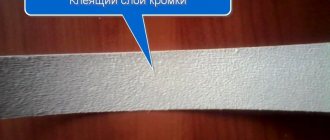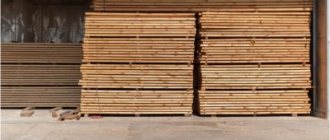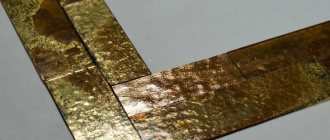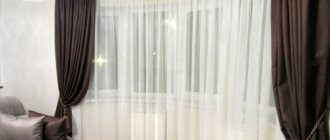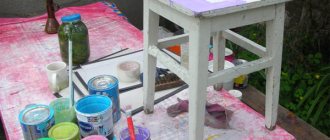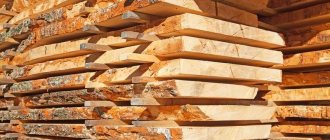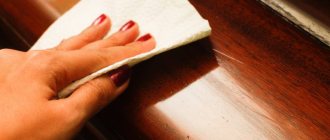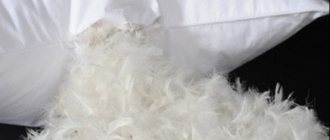Rice. 1. Preparing the ridge for natural drying: a - transverse slits are made on the bark; b — the bark is removed in the middle part.
Some craftsmen prefer to cut voluminous crafts from raw wood. Then, of course, there is a possibility of cracking of the finished craft when it dries. To reduce this likelihood, carvers have come up with some tricks. From a block of wood it is necessary, for example, to make a column for a gate or wicket, a baluster for a porch, etc. In this case, an axial through hole is often drilled into the craft (churak), which helps the block to dry from the inside. The hole is then drilled out to a diameter of 40.50 mm. How to do it? We'll talk about this another time.
| Rice. 2. A longitudinal cut in the trunk protects it from cracking. |
Often, immediately after processing, the outer surface of the craft is roughly coated with vegetable oil; this protects the wood from intense drying from the outside, and therefore from cracking. Many craftsmen use this technology for drying finished products, since it is easier to cut a bulky item using raw wood. If the master decides to make a carved support column from a long log, then a longitudinal groove with a depth of 4.5 mm greater than the radius of the log is simply formed on the log using a circular electric saw on one side (Fig. 2). This gap will greatly prevent the trunk from cracking during drying. Subsequently, the cut is sealed with an insert using waterproof glue, and the column is installed so that the cut is not visible.
Drying wood in grain has long been widely used in Rus'. The wet wooden blank was buried in the grain closer to spring. Over the course of several weeks, the grain absorbed all the moisture from the wood. Then the workpiece was kept at room temperature and safely put into use, without fear of cracks appearing.
“Excess” water in softwood (pine, linden and others) can be removed by boiling the pieces in fresh water. When boiled, wood is freed from internal moisture and becomes more elastic and softer. Spoons, salt shakers and other kitchen items were usually immediately cut out of such steamed wood. Cutting raw hot logs is a pleasure. The products are dried in room conditions. I note that thin-walled dishes cut from boiled wood dry out so quickly that cracks simply do not have time to appear. Boiling wood in salt water also prevents it from cracking. Along the way, salt reliably protects the wood from putrefactive microbes. At home, small pieces of hard and soft wood are boiled in saucepans. Add 4.5 tablespoons of table salt to 1 liter of water. The wood is simmered over low heat for 2.3 hours, then dried at room temperature.
Boiling small fragments of hard wood in oil and drying oil not only eliminates the appearance of cracks, but also enhances the decorative value of the wood. The preparations are “boiled” in linseed or cottonseed oil, as well as in natural drying oil. Oil displaces moisture, filling the intercellular space in wood. The boiled wood is dried at room temperature. Dried wood becomes stronger, sands well and does not absorb moisture. A long-known and widely known method of drying blanks or finished products made on a lathe is to bury them in shavings. Carvers “buried” unfinished products in shavings or sawdust, where they dried evenly and did not warp or crack.
Drying on a cement floor is based on the ability of concrete to absorb moisture. Raw blanks are laid on a dry, clean concrete floor. During the day, the workpiece is turned over several times so that alternately one or the other plane is adjacent to the concrete floor.
A master who knows well the structure and mechanical properties of wood can even direct the drying process in the right direction at his own discretion using a saw, drill, chisels and an ax.
Source: idea-master.ru
How to dry wooden products?
Drying methods
lumber: The first method is to lay the timber or board on a flat surface indoors. Then each one is individually wrapped in newspaper and film. After 8 hours, the tree should be unrolled and the wet paper replaced with dry paper.
Interesting materials:
How to infuse ash for watering seedlings? How to set up a dripper for watering flowers? How should you water Dieffenbachia? How should you water Fuchsia? How should you water a cactus? How should you water indoor flowers? How should you water a small cactus? How to water tomatoes with iodine? How should you water spathiphyllum? How should flower beds be watered?
Rules and recommendations
To dry oak in large industries, drying chambers and the vacuum method are used.
At home, these methods are not available, since they require special equipment, which is expensive. Another effective method is under the influence of electric current, but in Russia it is practically not used due to its high cost. Before drying the material, it is recommended to remember the following rules:
- Oak wood dries out easily. This means that when the humidity drops below 7%, the product will begin to crack, both inside and out.
- The longest time will be required to dry fresh wood with a moisture content of 25%.
- If you start drying immediately by raising the temperature above 50 degrees, the internal capillaries of the wood will begin to collapse and the product inside will become covered with cracks. This will not affect the appearance, but the fragility increases by 75%.
- High-quality drying is carried out only by maintaining uniform temperature and humidity.
How to properly dry oak is planned, since the final percentage of moisture depends on the tasks and purpose of use of the product. The tasks of drying oak can be considered in the table:
| Task | Permissible final percentage of humidity,% |
| Drying without changing linear dimensions | 30 |
| Transportation | 20–22 |
| Operation and production of furniture elements | 6–12 |
Complete drying is used only in the manufacture of furniture or small interior design elements. For medium and large sized lumber, processing for transportation and storage is sufficient.
Several available methods for preparing wood
For home processing, the following methods are used:
- Dry the oak tree in advance. The required tree is marked in advance on the plot and in the spring the bark is removed from it, right from the roots to a height of 20–30 cm. The juices will not be able to reach the crown in the required volume and the oak will dry out. In the fall it is cut down and cut into timber.
- Natural drying. Oak wood of natural moisture content is purchased. The material is laid out under cover on the site, so that the wood is blown from all sides. The material is laid on chocks in layers. The distance from the ground to the bottom row is at least 300 mm. Drying time is 3–6 months, depending on climate and humidity.
- Drying small items indoors. The oak product is wrapped in newspaper in 5–8 layers and covered with PVC film on top. Holes are made in the film for ventilation. The product is placed on the windowsill above the battery. Once an hour the package is turned over. The process takes 2–3 days. This is the most affordable way to dry a wooden product at home.
Drying large oak timber at home is difficult. The most affordable option is outdoors. But wood is hygroscopic and easily absorbs moisture from the air. That is, if drying is carried out during the rainy season, the process becomes useless. The easiest option is to harvest wood from the winter forest. In winter, at temperatures below -20, oak wood acquires moisture equivalent to chamber drying. Therefore, products from winter forest do not require additional preparation.
Oak drying
When choosing oak for building a house, furniture elements or individual structures, you should understand that poor-quality drying can lead to changes in the parameters of the finished product for the worse. Due to the increased moisture content and uneven drying of the lumber along its length, it begins to deform.
And this becomes a significant problem when carrying out any type of construction. Therefore, it is very important to organize high-quality drying of wood before using it in business.
General drying rules
Wood can be easily overdried (the degree of humidity drops below 7%, with violations of the technology and drying time). This condition has a special term, “dryness.” It is fraught with cracking of the material, not only from the outside, but also from the inside.
The process of organizing the drying of freshly cut lumber, the moisture content of which usually exceeds 25%, is very problematic. If, at the initial stage of drying, the temperature in the chamber is raised to a value exceeding 55 ° C, this provokes the collapse of the oak wood capillaries and the formation of significant internal cracks. At the same time, the appearance suffers slightly, but the strength drops to 25% of the original. The material becomes very brittle.
Selecting the drying mode and technology
Oak lumber is dried taking into account the achievement of a specific task. They are subjected to similar treatment in three cases:
- When drying is carried out without changing the geometric dimensions of lumber (humidity is reduced to 30%);
- Products are dried for subsequent transportation and storage (20-22)%;
- For the subsequent production of furniture elements (6-12)%.
As a rule, it is enough to dry large and medium-sized building materials to transport moisture levels.
For industrial purposes, oak lumber is dried in special chambers equipped with programmable controllers that automatically maintain TVR in it.
The required parameters are set either by the drying gradient and temperature, or by the temperature indicators of the “wet” and “dry” thermometer (in a psychrometer).
As a rule, regardless of the type of chamber (convective, vacuum, IR), there are two basic drying phases in its operation:
- The first is designed to reduce natural humidity to (26-30)%. In this case, the parameters of the gradient and temperature are stable throughout the entire time of this phase;
- The second provides drying from 30% to the specified value. The gradient and temperature are higher. By the end of drying, the first parameter increases. A number of modes provide for a simultaneous increase in temperature.
“Surprises” of drying oak lumber
The material is characterized by a significant variation in the moisture content of freshly cut lumber (even within one beam or board). It all depends on the installation point of the sensor that measures it (namely, their information affects the operation of the automatic drying control).
As a result, the drying chamber controller can (based on averaged sensor information) switch from the first phase to the second at the moment when the loaded batch of wood reaches a moisture content of (26-28)%. However, many oak boards still have areas with higher humidity. As a result, they will begin to crack.
To avoid this problem, specialists involved in drying lumber perform intermediate condensation. During this operation, the gradient is manually set to a value (1.2-1.5) and the material is kept in this mode for 10 hours to 24 hours. Only after this the second drying phase is started.
Natural (atmospheric) drying of oak
Natural drying of oak is a rather complex and difficult process. This type of wood is very strong and hard, which is why capillary liquid is practically not removed from it.
Which, in the future, when it dries, leads to a change in linear dimensions and overall parameters. After seemingly high-quality drying, the wood becomes crooked and unusable.
There are many technologies for drying oak. For example, large and small manufacturing companies and developers often use convective drying chambers.
In such installations, wood is dried by a flow of hot air, which removes moisture from the lumber. But due to sudden heating and excessive drying, the lumber begins to:
In this case, even heavy loads and a length tie rarely help.
And the drying time for oak with a thickness of 70 mm will take on average 70 days (1 mm per day).
which is an incredibly long time for a manufacturer.
Drying oak in vacuum chambers
To avoid all these problems and speed up the process of heat treatment of oak lumber, special technological modes were developed for vacuum chambers.
In them, the temperature of the heating elements fluctuates around 50 degrees, and with the ability of a vacuum to draw liquid from deep layers and boil the liquid already at 45 degrees. The lumber dries in a soft mode with excellent quality.
Methods in production
When preparing wood in production, chamber drying is used. The oak is placed in a special sealed convection chamber. Under the influence of high temperatures and ventilation, excess moisture gradually evaporates and the wood dries. The process is carried out in three stages:
- Wood heating.
- Drying.
- The oak cools and acquires the desired humidity.
The camera is constantly monitored, because if the process is disrupted or a mistake is made, the product begins to twist or crack. The kiln drying process lasts from 1 to 3 weeks. But many manufacturers shorten the process and the wood does not dry out completely.
It is important to check the moisture content of the wood from the inside before purchasing. For this, a manual moisture meter is used.
The vacuum drying method is carried out in special chambers, where, under the influence of atmospheric pressure and high temperatures, the minimum moisture content of lumber is achieved. The vacuum method is used in production for preserving wood, since in the chambers the product is additionally treated with antiseptics. The compounds penetrate deep into the wood under the influence of vacuum. This increases shelf life and improves product quality during transportation. The vacuum method is difficult to reproduce at home, as special equipment is required.
Chamber drying, due to its high cost, is gradually fading into the background. A new method is replacing it - infrared preparation. Infrared treatment reduces drying time and saves electricity. At the same time, the effect on oak wood is uniform and soft, and does not destroy the product from the inside and outside. Exposure to infrared heat makes it possible to obtain any percentage of humidity.
Know-how - preparation using infrared light
Infrared batteries can be used at home and in factories. The process requires cassette forms, which are located inside a special frame of metal stacks. The size of the battery depends on the number of cassettes, so 2–3 pieces are enough for home use. The amount of material processed simultaneously does not matter; the main thing is to position it correctly and direct the light. Treatment up to 6–12% is carried out within 6–7 days. To obtain 20–25% humidity, 2–3 days are enough.
Oak lumber after infrared exposure has the following characteristics:
- Has a specified humidity.
- The fibers do not deform, so there is no internal stress or microcracks.
- Externally, oak remains natural (color and shape do not change), as during atmospheric drying.
Humidity is checked during infrared exposure with a hand-held moisture meter. As soon as the indicators meet the set objectives, the dryer turns off. Immediately after the process, the dried lumber can be used in work. The process is shown in more detail in the video:
Since oak is capricious and does not react well to temperature changes, the optimal drying methods are natural or infrared. They are suitable for home use and do not require any special preparation. In large industries, chamber drying or vacuum preservation is used. Which significantly reduces time and extends shelf life.
Source: infobrus.ru
Order a call from the website: kak-sushit.ru
| Good to know |
| Questions and answers |
Question: How to avoid defects when drying lumber? Reasons for its occurrence Answer: There are four main reasons for marriage: 1. Drying too quickly.2. Drying too slow.3. Improper stacking.4. Operational errors. These reasons lead to the following types of marriage: .
LLC “DAKT.RU”
, Moscow
Phones: 8 +7 8
Address: 127576, Moscow st. Novgorodskaya, building 1 room G 235
Source: www.kak-sushit.ru



